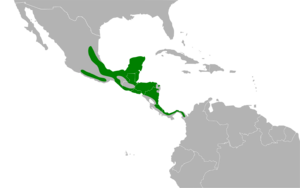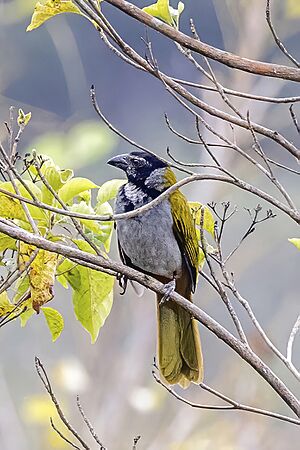Black-headed saltator facts for kids
Quick facts for kids Black-headed saltator |
|
|---|---|
 |
|
| At Cordillera de Talamanca, Costa Rica | |
| Conservation status | |
| Scientific classification | |
| Genus: |
Saltator
|
| Species: |
atriceps
|
 |
|
The black-headed saltator (Saltator atriceps) is a cool bird that loves to eat seeds. It belongs to the tanager family, called Thraupidae. You can find these birds living in an area that stretches from central Mexico all the way to eastern Panama.
Contents
What Does the Black-headed Saltator Look Like?
This bird is about 24 centimeters (9.4 inches) long. It weighs around 85 grams (3 ounces). That's about as much as a small apple!
Colors and Features
Adult black-headed saltators have a dark, slate-grey head. They have a whitish stripe above their eyes, like an eyebrow. Their upper body is a yellowish-green color. The underside of their body is light grey. They have a white throat with a black edge, which looks like a black bib.
Their beak is thick and black. Their legs are brown. Young birds are not as brightly colored. They might have spots on their chest and brown marks on their belly.
How It Compares to Other Birds
The black-headed saltator looks a bit like the buff-throated saltator. But the black-headed saltator is bigger. It also has a darker head and lighter grey underparts. The buff-throated saltator has a yellow patch on its throat, which is different.
Sounds of the Black-headed Saltator
These birds have some interesting calls and songs. Their common call sounds like a loud, rough deeeer.
Singing Together
The song of the black-headed saltator is a loud and scratchy sound. It goes cher cher jur jur weeee. Often, the male birds will sing this song together, like a duet!
Where They Live and What They Eat
The black-headed saltator loves to live in places with lots of thick plants and trees. They prefer dense vegetation.
What's on the Menu?
These birds are not picky eaters! They enjoy a variety of foods. Their diet includes fruits, plant buds, and sweet nectar from flowers. They also like to eat slow-moving insects.
They usually look for food at low and middle levels of the plants. Sometimes, they even join other types of birds to forage together in what are called mixed species flocks.
Nesting and Eggs
Black-headed saltators build their nests in thick bushes. They usually place their nests up to 3 meters (10 feet) high.
Building a Home
Their nest is shaped like a cup. It is made of bulky grass and lined inside for comfort. They build these nests between April and July.
About Their Eggs
Female black-headed saltators usually lay two eggs at a time. The eggs are a pale blue color with black marks. Each egg is about 24 to 34 millimeters (0.9 to 1.3 inches) long. They are about 18 to 23.5 millimeters (0.7 to 0.9 inches) wide. Each egg weighs around 4.9 to 5.5 grams (0.17 to 0.19 ounces).



